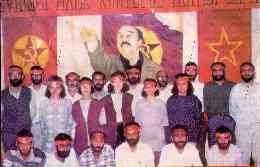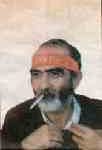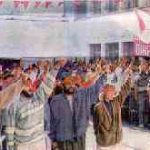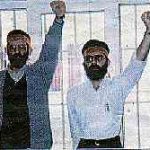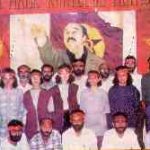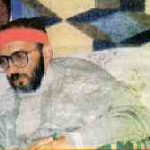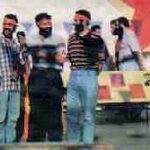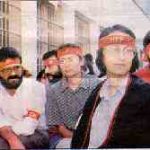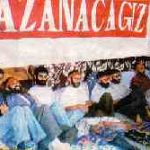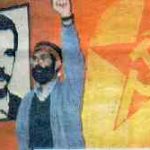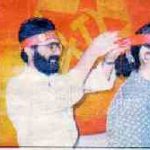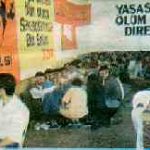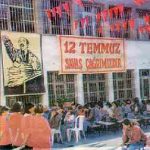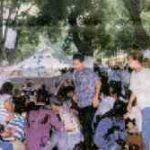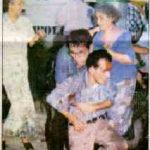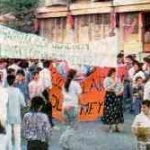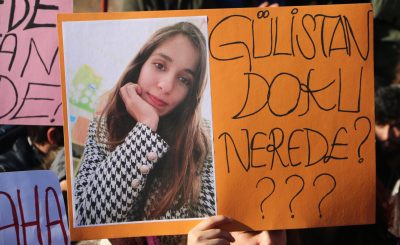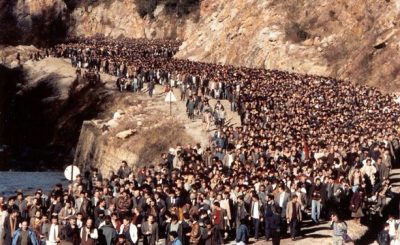In prisons
Actions outside of prisons
Relatives on the solidarity hunger strike
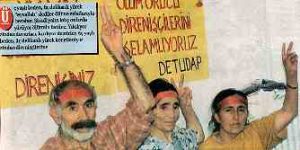
The victory in the Death Fast of 1996
Kurtulus Number 90 July 18, 1998
The victory in the Death Fast of 1996 was achieved with the politics of the DHKP-C and the martyrs. Final victory will also be achieved by following this path.
Two years have passed since the Death Fast of 1996. The victory gained two years ago with 12 martyrs continues to show the way to drive the struggles forward on various fronts. This victory has historic significance, with its preliminary phase and the phase that came afterwards it plays a decisive role in determining what victory and defeat is and what separation and unity mean.
Bourgeois ideology suffered a defeat. Victory was gained by revolutionary politics which rejected surrender, continued the struggle under all conditions, was not afraid that the struggle would result in victims and created traditions of forming and maintaining ties to the people and the revolution and the culture of readiness for self-sacrifice. Every kind of reformist and opportunist conception was removed from Marxist-Leninist culture. While the separation of reformism was experienced during the Death Fast itself, the splitting off of opportunism was essentially completed in the subsequent period. The results and influences of the Death Fast are too wide-ranging to be expressed by saying that some rights could be won or restricted in such and such a time and place. The victory has defined the two years since from different viewpoints. Victories extending into the future require broader shoulders capable of bearing them. Through negative or positive developments, the influence of the Death Fast has shown who and what unity achieved victory, how the subsequent phase is to be evaluated and who has the strength to go further with what has been achieved and who does not.
The Death Fast is a political and ideological victory more than anything else.
In the political sense it brought all the enemy’s political calculations to nought and halted his policy of aggression. In the ideological sense it unmasked the egoistic culture of the bourgeoisie, its anti-popular policy and its fascist face and opened the way for the people to take their place in the ranks of the revolution.
The meaning of the remark “in their brains a quake was unleashed and the world was turned upside down” lies in this ideological victory. An ideological victory which destroyed the lack of conviction of those who said “it is not worthwhile to die for an ideology”, the revolution was made concrete before the eyes of the people, a personality was displayed and the people’s hate for the system was deepened, and a political left which could never go forward from abstract unity achieved at a negotiating table, united in an action which grew in significance because of the deaths.
This remark was made right after the victory: “Besides having the function of a barricade against the attacks of the bourgeoisie, besides achieving rights for prisoners, besides unmasking the fascist face of the Refah Party, its real function was to deliver a heavy blow to the lack of conviction and pessimism that the bourgeoisie encourages. The real gain from this resistance is the victory in ideological struggle with the bourgeois ideology, the moral superiority. The superiority of the Marxist-Leninist ideology over bourgeois ideology was proved yet again.” (M. Ali Baran, Kurtulus, August 3, 1996)
The world and the country was shaken to its foundations, and everyone was shocked. This struggle with death showed everyone their place, whether positive or negative. Once more it was proved that the revolutionaries and the people cannot be defeated.
The Death Fast was a struggle of two ideologies, two wills which gave ideology its direction:
The bourgeoisie had said there is no longer an ideology worth dying for. The revolutionaries declared and proved that there are values and ideologies for which one dies.
The bourgeoisie raised egoism and self-interest to the level of a principle. The revolutionaries strengthened sharing, collectivism, offered a major example of readiness for self-sacrifice and showed the people the growing power of their values.
The bourgeoisie divides the people and stirs them up against each other. On the other hand, the fighters of the Death Fast, of Kurdish, Turkish, Arab, Cherkess and Georgian origin amongst others, united the people, organised them and showed the fraternity and solidarity of the peoples.
The bourgeoisie treats dishonour, greed for money, and every kind of swindling as though these are virtues. The Death Fast and its fighters, in contrast, strengthen honour and dignity and treat people with respect. In the period of the Death Fast the politics were clearly shown through which the revolution can be achieved and through which the revolutionary cadres who have the leadership in the liberation struggle can hold on to it. Leadership, as politics and as cadres, crystallised in such a way that they can be seen by very broad masses. Broad masses of people were given the possibility of comparing parties, leaders and politics.
At the same time, the scale of the victory placed a heavy load of responsibility on those who won the victory.
The actual significance of the victory, the ideological and moral superiority should be concretised in the struggle and the unity of the people. If the political results created in the Death Fast are not transformed into political practice afterwards, the attacks by fascism, which is again trying to win ideological and moral superiority, cannot be opposed. Then the victory is restricted to one of having simply beaten off the attacks that went on back then and the historic mission of the Death Fast cannot be fulfilled. War permits no pause for breath. Nor does it permit one to squander an inheritance. It is impossible to develop and organise oneself by basing oneself on a victory one has not achieved for oneself. These are the rules, these are the realities of war. If we look at the Death Fast of 1996 and the subsequent struggle from this viewpoint, we can clearly recognise that the Death Fast united people but the victory separated them. While the opportunist left together with the victory went into a stage of erosion and collapse, the Party-Front was legitimised in the eyes of the people and its mass power grew and it travelled an important distance along the road to taking power.
Because opportunism restricted the victory to beating off the attacks of 1996 and the phase after it, and was preoccupied with thinking, “How can I put myself in the foreground?”, because they only made propaganda from the victory and the martyrs, they overturned the line that had actually achieved the victory.
Instead of an analysis of what kind of period had been lived through in the prisons up to victory, all they did was engage in sterile agitation. Instead of a joint struggle, instead of decisiveness, instead of going over to the attack, instead of forcing the legitimacy of the revolution on the bourgeoisie and the necessity of serving the masses, they preferred to put their own narrow group interests to the fore. The victory was not used to organise the people but rather to advertise their own groups. This went so far that the left did not fear destroying the unity of the left and the people.
The unity achieved in the prisons showed that a unity of revolutionary forces on the basis of a correct line can win. But a left which neither knows how to learn from the struggle nor from history was also incapable of learning from a struggle achieved with martyrs. With policies like splitting up unity into different areas, unity was eroded within two years. In this situation, the left which was opportunist, obsessed with advertising itself and only serving its own interests and which got itself into a cul-de-sac of pursuing an anti-Party-Front policy might as well have carried out the policy of attacks and marginalisation after the Death Fast themselves.
This was what was experienced in the Susurluk period. Without displaying any far-sightedness and influenced by hostility to the Party-Front, an important phase was not analysed from the viewpoint of people’s unity. Nothing came of the unity.
Without even trying to destroy the politics of the MGK (National Security Council) which was trying to create a clash between Sharia (Islamic law) and secularism in an effort to integrate the people in the system, the MGK left and the reformists united on the basis of being against the Party-Front. Conforming with the system was promoted. Those who feared that they would slip into obscurity, who were afraid they would disappear or erode if they acted together with the Party-Front found that their fears were justified when they took a position against the Party-Front.
This behaviour of the left is not to be wondered at. The history of the opportunist left before the Death Fast already showed their attitude of being only interested in their own advantage and seeking self-advertisement and wanting to compete with others, while being hostile to the Party-Front and constantly deviating to the left or right. They were the ones who in 1984 had dismissed the Death Fast of that year as “suicide” and “political murder”. Nor was that all. When in the 1990s the fighters of the Party-Front fell while pursuing the policy of not capitulating, others designated this policy as “thirsting for confrontation” and preferred to stand apart from the struggle. Nor was their participation in 1996 the result of a serious analysis of the period. However, conditions were very different from the period earlier in 1984. The form of resistance they had formerly shunned was on everybody’s agenda, everything was obvious to the people, the thick prison walls might just as well have been of glass. There was no haven the opportunists could seek refuge in.
Nobody could propagate theories of “retreat” any longer. Moreover, they had seen the outcome of the Death Fast of 1984 which they had criticised and they realised that they would not profit from opposing such a major resistance and did not want to be outside it. So on the one hand their participation was positive: they did not want to be outsiders. On the other hand they showed ideological formlessness by by not making an analysis and self-criticism over the past.
Ultimately, they were responding to the influence and proposals of the Party-Front and the ideology it created in the action they took. They gave martyrs. This is undoubted, in the same way that for every political movement there must be a basis from which strength can be gained in the fight for power. But they persisted in their errors and this prevented them from analysing this basis correctly and making use of it. So after the victory they started to fall behind.
Reformism is afraid of victory because the Death Fast concretised the revolutionary alternative
The reformists, in other words the current MGK left, were another circle who split off because of the victory.
While the revolutionaries headed off to death to beat off the attacks and summon the people to struggle, the reformists, especially the ÖDP (Freedom and Solidarity Party) and the EP (Labour Party, today EMEP, Party of Labour ) locked themselves in in their buildings to ward off the attacks of the MGK. While the people were exposed to attacks, these groups renewed their preferred game of calling for “fresh elections”. Their minds had surrendered to the system and they could not believe that such mass heroism was possible. When actions grew bigger, and they were in danger of losing their mask, they called for a truce and thus de facto they supported the efforts fascism was making. Only in the final days did they try to do something, and this was because they were forced to.
In spite of everything, the victory astonished them.
They victory shook their way of life, the system and their status quo among the people. In a panic about the danger to the status quo, they attacked the victory. They were aware of its role in separating the people from the system and drawing them into armed struggle. These groups went over to the side of the enemy in order to stop growing participation in the struggle and the armed struggle and to block the channels leading the people to revolution. Against the development of the armed struggle and the people’s movement they put themselves under the orders of the MGK. They betrayed the people by obeying the MGK in the Susurluk period and on May Day in 1997 and 1998.
Yes, the victory has brought some together and separated others. While opportunism, which is losing influence as a result of its declining strength, was uniting, reformism became more and more part of the system. Moreover, it could be seen how both were united against the initiatives and mass support of the Party-Front, above all in the neighbourhoods and workplaces. Both fell well behind the point they were at before the Death Fast, opportunism because the victory overwhelmed it, and reformism because it was afraid of it. In this situation, without an analysis of the past and self-criticism it is obvious that they will fall even further behind.
The Death Fast victory is continuing to show the way.
Since opportunism and reformism cannot, it continues to show the people and Party the way to achieve power. The Party-Front will march along this road. Victory means power. Every victory means a step on the road to final victory. If there is deviation from the line that achieved these victories, those that have been gained will be betrayed and more importantly, the chance for final victory will be lost.
Every one of our martyrs in the Death Fast is hope for the people, a source of fear for the enemy and a road sign for the comrades. A condition for continuing the struggle is to create new cadres every day and increase their number, for they will lead the revolution to victory. It is the task of the Party-Front to continue to be fighters of the Death Fast, to give the people hope and cause fear among the enemy.
The DHKP-C means victory.
The leadership, ideology, cadres and fighters of the DHKP-C are the guarantee of victory. The DHKP-C continues to show the way to victory, going forward along the line created by the victories. It continues its march along the road to final victory.

